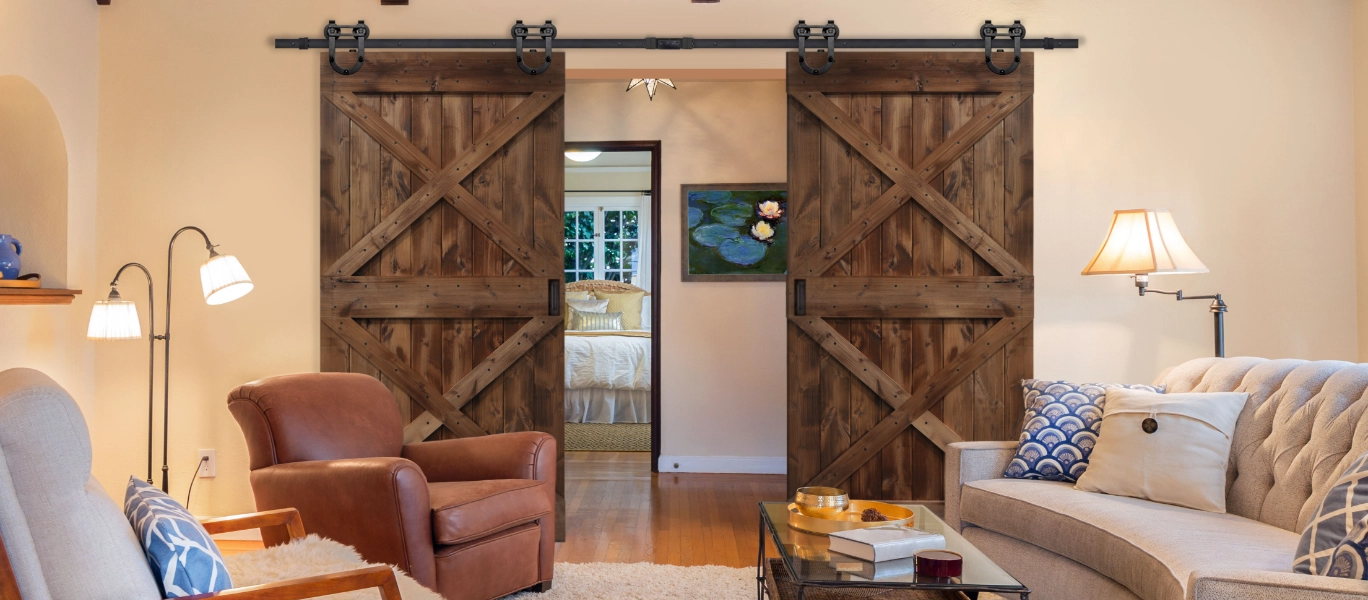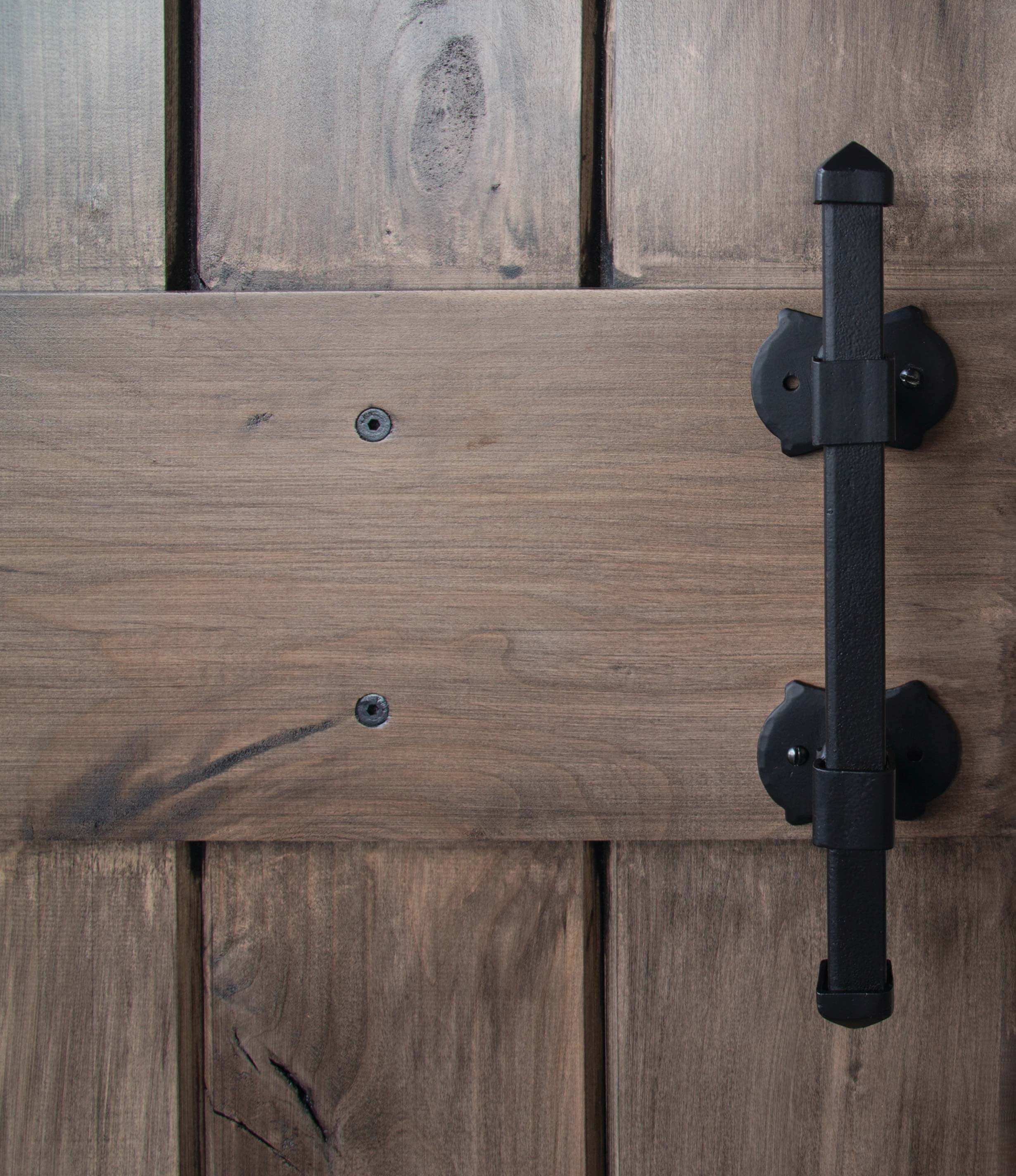 Barn Door Hardware Buying Guide
Barn Door Hardware Buying Guide
Buying interior barn doors gives you the chance to have a little more fun with your choices than exterior doors does. Since you don’t have to worry so much about durable locks or materials that can withstand the elements, the primary limit is your preference. Plenty of homeowners take advantage of this and install interior doors designed largely for decoration. A barn door--a door that slides open to lay flat against the wall--is just one example.
But the door itself is just the first step. Barn door hardware is just as involved as hardware on any other door style. How do you know what hardware to choose? Let’s take a look.

Table Of Contents
Your Barn Door Hardware Kit Checklist
Choosing Durable Barn Door Hardware
Mounting Your Barn Door
Before you purchase any barn door hardware, decide how you’ll mount the final product. Barn doors tend to be mounted in one of three different styles. First, and most commonly, is the single-mounted door style consisting of one door panel mounted on one track. This design requires only enough space on one side of the door to allow it to slide completely out of the entryway. Most barn door hardware kits are designed with single-mounted doors in mind.
Second is the double door style, where two door panels are mounted on the same track and slide in opposite directions to open. This layout requires enough room on both sides for the panels to slide out of the way. You can easily use a standard hardware kit for this style, though you will have to extend the track.
Third is the bypass style, where two door panels are mounted on two different tracks, one in front of the other. Both doors can slide along the entire length of their tracks and can be “stacked” on top of each other when the door is completely opened. You might go with this style if you need double barn doors but only have enough wall clearance for one. You will need to purchase some additional hardware to correctly mount both tracks.
Your Barn Door Hardware Kit Checklist
You should also consider the door you’ll be installing. What are its dimensions? What is it made of? How much does it weigh? Barn door hardware kits are designed with specific measurements and weights in mind. Don’t waste time and money on a kit that doesn’t work!
This is what you’ll find in most standard barn door hardware kits:
-
Track: a metal bar mounted above the door opening. Your door will be hung from this.
-
Rollers: little wheels mounted on the track to allow the door to move smoothly. You’ll need at least two for a single standard-sized door.
-
Hangers: small metal plates that attach the door to the rollers.
-
Door guides: tiny wall-like metal pieces mounted to the floor to prevent the door from swinging.
-
Stops: barriers mounted at both ends of the rail on the floor to keep the door from sliding off the track.
-
Jump blocks: round (sometimes square) pieces of plastic or metal mounted on top of the door to keep it from “jumping” off the track.
-
Standoffs (sometimes called spacers): tube-like pieces mounted behind the door track to prevent the door from scraping against the wall.
-
Connectors: metal plates used to connect tracks together for particularly long doors. Depending on the dimensions of your door, you may not need these.
-
Bypass brackets: L-shaped brackets that mount to the wall and hang over the inner track to hold a second track. These are only used for bypass double-door styles.
Once you have the essential mounting hardware, it’s time to consider decorative or simply nice-to-have barn door hardware:
-
Door pulls: handles to pull the door open. Some homeowners may prefer “dummy knobs” that don’t turn. You can also use a handle meant for a large appliance, such as a refrigerator, instead of a conventional door pull.
-
Flush door pulls: handles that create “grooves” in the door used to pull it open or closed.
-
Clavos: decorative nails that can be added to the door’s pattern for additional character.
-
Faux hinges: decorative metal strips mounted to one side of the barn door. These are designed to mimic the long metal hinges typically seen on rustic barn doors.
-
Locks: barn doors generally don’t need locks. However, if you choose to add one, you have two different options:
-
Privacy latches: simple latches (such as a hook-and-eye design) to hook the door to the jamb.
-
Locks: these locks are slightly more involved. A tiny thumb-turn on the door inserts a latch into a hole on the door jamb, similar to a conventional door latch. This style is best for barn doors that lay flush against the jamb when closed.
-
-
Soft closers: a set of pistons that prevent the door from being slammed shut.
-
Hush wheels: an alternative to typical hangers. These wheels are designed to make the barn door open and close almost silently.
One important thing to remember is that opening and closing even a simple barn door requires a decent amount of force. You may be tempted to save a few dollars and use a handle meant for kitchen cabinets instead of one meant for a sliding door. Don’t make this mistake! Cabinet handles are nowhere near strong enough to withstand the force of opening and shutting a door. They’ll last for a little while, but in the long term, they will begin to give and can cause damage to your door. Save yourself the trouble and go with a proper door handle or sturdy appliance handle.

Barn Door Track Bar Options
Of all the things to customize on a barn door, the track itself may seem like an afterthought. However, alternatives to the conventional track can do more than just provide an aesthetic change. They may be necessary to get the door to fit.
A typical barn door track is mounted a couple inches above the opening, leaving room for the door itself to hang down. This isn’t an option in homes with high-cut doorways. In this case, your best choice is a low-clearance track.
This type of track mounts directly on top of the door, removing the need for several inches of clearance on top. It also presents a slightly more modern look for homeowners wanting to avoid rustic decor.
Like the low-clearance track, a no-show track requires almost no overhead clearance and gives you plenty of flexibility in where to mount the door. But this one has an added bonus. The track, wheels, and other hardware are mounted on the interior side of the door, hidden almost entirely from view. This setup is ideal for homeowners that want to give the door a uniform, minimalistic look.
Matching Your Home Design
The barn door you’ve chosen likely blends well with your home’s overall look. Its hardware should do the same!
As you shop for barn door hardware, keep several design principles in mind. First: the hardware should complement the door itself. For example, a rustic-style wooden barn door will clash with modern-looking silver pull handles. Likewise, a wrought-iron pull handle will look out of place on a white door with a frosted glass window. Take the time to match both color and style with your door.
Second: both the finished door and its hardware should complement the rest of your house. This might seem like a given. After all, a rustic door will look and feel out of place in a minimalist living room. But color plays an important role here too. Your door should match perfectly with the rest of the room while neither blending in entirely nor standing out like a sore thumb. Look for colors that complement your home design.
Choosing Durable Barn Door Hardware
You’ll have this new door for a long time. While choosing a style and color you love is important, don’t forget about durability!
Interior barn doors are sheltered from the weather, so you won’t have to worry about rain or sun damaging the door. But depending on where you install the door inside, you may have to choose special hardware. This is particularly true for bathroom doors. Steam from hot showers could cause chrome or iron hardware to rust with time, resulting in an unpleasant appearance and difficulty opening the door. You could just clean the rust off when it appears. However, the best way to deal with rust on your interior barn door is to prevent it from forming in the first place.
You have two primary options for durable interior barn door hardware. First, you can choose hardware that has been specially treated to resist rust and similar degradation. Unfortunately, this will limit your choices in both color and style.
Second, you can opt for stainless steel hardware. Since stainless steel resists rust quite well, you won’t have to wait for an additional coating. Best of all, with the right materials, you can paint stainless steel! Match your door with your home decor without having to contend with rust.
How To Choose Barn Door Hardware
As you shop for barn door hardware, remember the three most important qualities you’re looking for: style, functionality, and durability. Of course you want hardware that matches your new door and complements your home. But don’t forget that you also need hardware that will make the door do what you need it to do, whether that’s opening quietly with hush wheels or locking for privacy. Finally, remember that certain parts of your home will make rust-resistant hardware a requirement. Take the time to research all your options before jumping into a purchase.
Ready to get started looking? We carry barn door hardware kits, handles, rollers, rails, and other barn door hardware parts and accessories. Browse our barn door hardware here and finish your renovation project!


